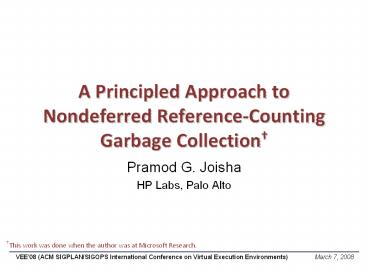A Principled Approach to Nondeferred Reference-Counting Garbage Collection - PowerPoint PPT Presentation
Title:
A Principled Approach to Nondeferred Reference-Counting Garbage Collection
Description:
A Principled Approach to Nondeferred Reference-Counting Garbage Collection. Pramod G. Joisha ... Making nondeferred RC garbage collection practical ... – PowerPoint PPT presentation
Number of Views:19
Avg rating:3.0/5.0
Title: A Principled Approach to Nondeferred Reference-Counting Garbage Collection
1
A Principled Approach to Nondeferred
Reference-Counting Garbage Collection
- Pramod G. Joisha
- HP Labs, Palo Alto
This work was done when the author was at
Microsoft Research.
VEE08 (ACM SIGPLAN/SIGOPS International
Conference on Virtual Execution Environments)
March 7, 2008
2
Classic RC Instrumentation
3
Unique Advantages
- Prompt reuse
- Cache effect gives performance benefits
- Low footprint
- Can run in a smaller heap
- Useful in memory-constrained environments
- Incremental in time and space
- No repeated traversals of long-lived data
- Spatial locality usually no worse than mutator
- Can present simpler overall designs
- No stack maps needed, at least in single-thread
case
4
What is Nondeferred RC Collection?
- Three invariants should always hold
- All live data have positive reference counts
- Reference count is zero when last reference
disappears - Zero reference count implies dead data
- Classic reference counting is nondeferred
- Deutsch Bobrows reference counting is not
- There are subtleties in the definition
- Last reference is from mutators standpoint
- Reference count could be zero even before
5
Deutsch Bobrows Reference Counting
- Approximate reference counts
- Only heap references tallied
- Zero-Count Table (ZCT)
- Threads paused to reconcile
- Stacks scanned to purge ZCT
- Remaining entries garbage
- Nondeferred invariants might not always hold
6
The Spectrum of RC Techniques
7
What is Different from Previous Efforts?
- Past work addressed optimizations
- Given a nondeferred app, how to make it faster?
- 2006 2007 ACM International Symposium on Memory
Management
- The line of work has an overarching goal
- Making nondeferred RC garbage collection
practical - Making general reference counting more efficient
8
Contributions of This Work
- Addresses main problems to conversion
- How to handle object-oriented instruction sets
uniformly? - How to insert RC updates to achieve early
reclamation? - How to do this in the midst of modern language
features? - Exceptions, object pinning, interior pointers
- How to treat the run-time system?
- Interaction of conversion with other phases
- Impact on downstream phases should be minimal
- Conversion has implications on inlining
9
Talk Outline
- The RC update insertion phase
- High-level process
- Code templates
- Trading code quality with eagerness
- The scope of the insertion phase
- How does the technique fare?
- Summary
- Some Further Thoughts
10
The RC Update Insertion Phase
11
Preprocessing Stage
- Motivation Normalize the IR
- Key step Subsume interior pointers
- Interior pointers similar to conventional
pointers - But can only be used in a few well-defined ways
- Should be honored by the garbage collector
- Approach Shadow interior pointer accesses
12
Analysis Stage
- Find dying references using liveness analysis
- Supplementary decrements may be needed
- If references are both defined and live on entry
to the statement s - If other references could be defined in s
- Liveness modified for pinned references
13
Injection Stage
- Three kinds of RC updates inserted
- RC increment, standard and eager RC decrement
- Operates in three steps
- Insert RC updates against definitions and deaths
- Insert RC increments against explicit
intrafunction throws - Insert standard RC decrements into exception
headers - Injection guided by code templates
- Based on classifying a statement as call or
non-call
14
Non-Call Statements
15
An Example
16
Issue with Representing the Eager Decrement
17
Trading Code Quality with Eagerness
18
Everything Shouldnt be Converted!
- All code in the run-time isnt converted
- Presently, C attributes flag special code
- PreInitRefCounts
- Bootstrap memory allocation, and static
initializers - RecursiveRefCounts
- Code transitively reachable from addref and
release - ManualRefCounts
- Methods that directly manipulate reference counts
- ZombieRefCounts
- Code accessing zombie objects
- Affixation rules can be mechanized
19
Related Work
- The use of liveness in GC isnt new
- But past work considers it for a tracing
collector - This work considers reference deaths
- Important distinction Arises from a basic
difference between tracing and reference counting - One looks at live matter and the other at matter
that is dead (see Bacon et al. OOPSLA04). - Certain complications are unique here
- E.g. exceptions
20
How does Nondeferred Fare?
Xlisp interpreter (SPEC CINT95 port)
21
Summary
- A systematic conversion algorithm
- Instructions are treated in a uniform manner
- Modern language features handled
- Degree of eagerness can be varied
- Conversion has implications on other parts
- Has been implemented in a compiler
- Many large programs have been successfully
compiled
22
Some Further Thoughts
- What remains for primetime?
- Optimizing single-thread heap reference counting
- Concurrent nondeferred reference counting
- Cycle reclamation
- Fragmentation
- An ecosystem of supporting tools required
- Presently, a memory leak verifier and profiler
exist - But more needed!
decreasing importance
23
Questions?































